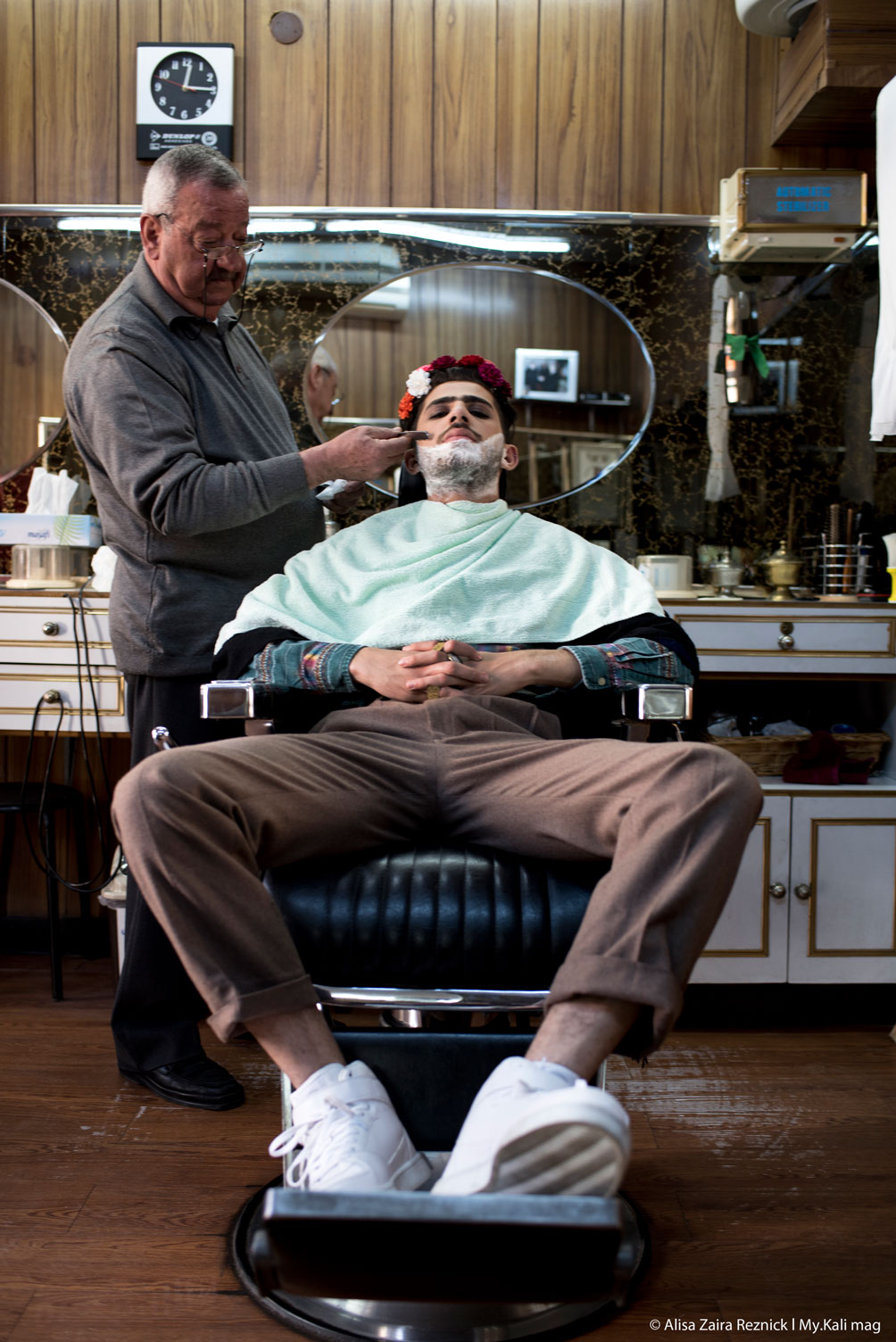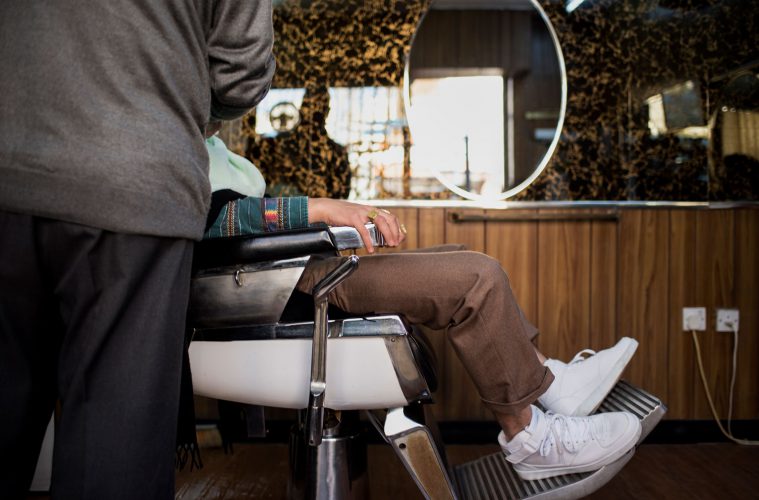Witten By Olivia Cuthbert
Photographed by Alisa Zaira Reznick
Make-up by Sara Arar
Styled by Fadi Zumot
Creative directed by Khalid Abdel-Hadi
Modeled by Elshab elauthentic (check full shoot here)
Amman – Jordan
‘Just manly men’. ‘Guys that hit the gym’. ‘Straight-acting only’. ‘No fems’. The message for gay and bi men browsing through dating apps in Jordan is clear: masculinity is in, femininity is out. Queer personas not encouraged. It’s a trend that some say is becoming increasingly apparent in Jordan, where a homogenous masculinity is diluting the diversity of the gay community as more and more men aspire to fulfil a gendered ideal. “People are changing to fit in,” says Khalid Abdel-Hadi, creative director of My Kali magazine. “I see it on my social media feeds all the time. Men adopting overtly masculine poses when I know they have a feminine side.”
Ayman Y*, a writer focusing on gender issues in Jordan, says there is an “epidemic” on the apps of the ‘straight-looking’ ‘straight-acting’ demand. He sees it as a self-hating mechanism within the LGBT+ community, “as if being straight is the idealistic ‘normal’ situation.” The phrase ‘no fems’ has also become familiar: “The issue here is that there is no awareness of the distinction between definitions of gender and sexual orientation. They say they only want a straight-acting, non-feminine guy, but why is the word straight associated with masculinity?”
Fear of the feminine
Exaggerated masculinity is also a form of self-preservation. In a society that collates womanhood with weakness and concentrates power overwhelmingly in the masculine space, there’s little scope for building a strong identity on female traits. “Any feminine expression is more likely to be looked down upon than any masculine expression,” Ayman says, pointing to the inferior status of women in Jordan.
It’s not just men that benefit from quelling any ladylike qualities. “Sadly, acting in a feminine way in public is unsafe for both men and women,” says Fadi Zaghmout, a well-known blogger, novelist and campaigner for sexual freedom. “With sexual harassment of women widespread, the less they flaunt their feminine attributes, the safer they are,” he says.
Men, meanwhile, are expected to maintain a macho authority befitting their superior social status. “This overly masculine culture swallowed the natural balance of masculinity and femininity that is needed in any healthy society,” says Zaghmout, pointing to the pressure placed on Jordanian men to fulfil a hyper-masculine ideal. “Feminine gay men challenge this shallow understanding of gender and make people feel uncomfortable,” he adds.
The gay community perpetuates this prejudice internally with terminology designed to derogate those who fall outside gendered ideals. A gay man with an effeminate air or flamboyant mode of dress is derided as خالصة or khalsah (over the top), referred to as إنتِ or ‘inti’ (the feminine form for you) and accused of being a بوتمة or ‘bottom’ in bed. “Using feminine language in the gay community is for two reasons; either to be funny or to shame another person, we don’t use it to celebrate female identity,” says Abdul-Hadi, an openly homosexual male.
Conforming to categories
Growing up in Amman, Abdel-Hadi channelled most of his teenage allowance towards buying imported magazines, spending JOD 15 on French Vogue, JOD 10 on InStyle and JOD 8 on US Cosmopolitan. Often, he’d have to invest in the same issue twice or even three times within the space of a month to replace copies confiscated by his mother. “She thought that reading these magazines meant I wanted to be a woman. For her, there was no difference between being gay and transgender.” This way of thinking is all too common in Jordan, where, he says, “Society doesn’t differentiate; people think that if you’re gay, you automatically want to be female.”
Confusion between gender and sexuality is equally prevalent within the LGBT+ community. “They don’t see that gender is about femininity and masculinity, while sexual orientation is not on that spectrum at all,” says Ayman. “It’s about which sex you are attracted to; you might also be straight and feminine or gay and masculine.” But in a country like Jordan, where gender binaries are rigidly defined, there’s little space to build an identity between the boundaries.
Ghada F* was 21 when she acknowledged to herself that she was gay but the realization presaged a struggle. “I became depressed because I thought that being gay meant I should fit a certain image, like being butch, drinking a lot and having multiple piercings. I didn’t know then that being a lesbian meant I could be myself, be feminine.” Advice from her therapist at the time only served to reinforce her confusion. “He told me three things: You shouldn’t only have queer friends, you’re too attractive to be a lesbian and, because of your masculine haircut and attire, you should be the one to adopt an authoritative role in your relationships.”
Those who don’t subscribe to fixed notions of gender in Jordanian society face formidable challenges. Luma T* had to go Europe to seek sex reassignment surgery and has since built a life abroad, but her journey began long before that growing up in Jordan. “Being transgender or transsexual is (seen as) shameful and taboo so I had a lot of difficulties seeking acceptance from friends and family. Our society is very conservative. For those who fall outside traditional definitions it can be extremely dangerous,” she says, referring to cases involving so-called honour crimes. “People in Jordan are afraid of what others think and want to preserve this image of having an ‘honourable’ family at all costs.

Pants, sneakers, flowers in hair all H&M. Shirt & rings, model’s own.
Imported identities
Pressure to conform to prescribed gender roles has not always shaped Jordanian society in the way it does today. Sana’a F*, a teacher and social activist living in Jordan emphasises the fluidity that once characterised attitudes towards gender and sexuality among the country’s Bedouin tribes. “This separation between the genders and their perceived roles is not something we have had throughout our history. It came with colonialism and the Victorian values it imposed on this region; that’s when we developed this idea of how men and women should look and act.”
Prior to this, she says, notions of masculine or feminine didn’t exist among Bedouin farming people; not in the way they are understood today. She recalls a friend’s grandmother who would wield a stick at lurking teenage boys eyeing up her teenage daughters in the street. “Strong women were respected, even admired then,” says Sana’a. “In a village setting, it was good to be able to switch between roles.”
Sexuality among Bedouin communities was also less compartmentalised. “We never used to have all these labels. There were same-sex relationships but no one ever called them that because it was something very natural,” she adds. It’s something that activists in Jordan and other Middle Eastern countries have highlighted as they work to create a safe and hospitable environment for LGBT+ communities across the region. Many emphasise the importance of developing a home-grown LGBT+ scene that builds on this heritage while remaining distinct from imported identities and the stereotypes that come with them.
Cultural contradictions
Though far from hospitable towards same-sex relationships, homosexuality is not illegal in Jordan. Most of the laws criminalising homosexuality in countries across the Middle East come from British and French legislation, left over from colonial times, says Musa Shadeedi, an author whose published works include The day we never had a father. “Such rules didn’t exist here before” he explains, highlighting the cultural contradictions that expose the incongruity of these sexual mores in Middle Eastern settings decades on.
While identifying as gay is taboo in Jordan, there are certain scenarios when it’s considered acceptable for men to sleep with men. “The identity may be new for us in the region but the act is very old in our culture,” Sana’a says. She cites examples such as taba’a awlad, characterised as a feminine, usually younger male who is used as a vehicle for sex by other men, often because they lack access to women. These men don’t define themselves as gay. “It’s seen as a sexual act without a sexual orientation,” she explains.
Meanwhile, the tactile friendships common among Jordanian men are in stark contrast to strict codes prohibiting public displays of affection between men and women. A recent post on the Facebook page of one of Jordan’s major cities went so far as to suggest that gay men are given free rein in Jordan compared to heterosexual couples: “Our male friendship culture has very homoerotic tendencies…you can see this behaviour very publicly in the streets and people don’t react. On the other hand, if a man holds his girlfriend’s hand, or posts a picture of them kissing or hugging one another, there will be an outcry.”
This commentator goes on to question the LGBTQ+ community’s right to complain about discrimination when social customs effectively allow gay men, as he sees it, to hide in plain sight. But, as Sana’a points out, it’s the labels that steer society’s response. “They’re very comfortable with bromance – guys holding hands or hugging one another – so long as the men doing it are straight. It’s when it comes to having an identity that’s queer; that’s when a rule has been broken.”
Private personas
Similarly, the laws of gender must be seen to be upheld. “For a man to renounce his masculinity in today’s hyper-masculine society is simply unacceptable,” she adds. Where once LGBTQ+ circles might have been an exception to this rule, pressure to conform to macho criteria appears to be gaining traction among gay men. “The appetite for femininity in the gay community is fading. On Grindr, if you seem effeminate, you’re not approached. It’s driving the gay community to change, to become more masculine,” says Fadi Z, a fashion designer and stylist in Jordan.
Abdel-Hadi worries that this increasing trend towards conformity is denying the community the visibility needed to support LGBTQ+ advocacy efforts and bring about positive change. “The fewer people seen to be challenging gender distinctions and widening the space for LGBTQ+ expression in Jordan, the smaller it will shrink,” he says. This was the impetus behind the current issue’s photoshoot featuring a male model dressed as Frida Khalo, a Mexican artist known for transcending gender boundaries through her paintings and in life. “These narrow interpretations of gender and sexuality need to be constantly challenged to create space for those who don’t fit in,” Abdel-Hadi says. “The more the eye rests on images like these, the sooner they start to seem normal.”
*Names have been changed
Check the full shoot here

